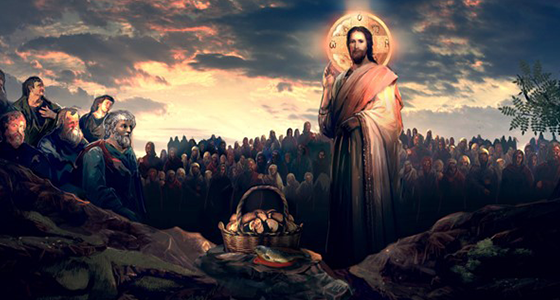The Food Which Endures to Eternal Life

We read of Jesus instituting the Eucharist in the Gospels of Matthew, Mark, and Luke, as well as in St. Paul’s first letter to the Corinthians. John gives us something different, which is not surprising: John wrote his Gospel long after the other three, and he assumes you’ve read them already. His Gospel is meant as a sort of “gap-filler,” covering important moments in the life of Jesus that nobody else had written down yet. He offers us the “the rest of the story.”
Instead of focusing on the Eucharist at the Last Supper, John looks at Jesus’ teaching a year earlier, in which he first broaches the idea of the Eucharist. In case we miss the connection, John tells us that “the Passover, the feast of the Jews, was at hand” (John 6:4), and we know that it’s on the following Passover that Jesus will institute the Eucharist at the Last Supper. I’ve mentioned this part of John’s Gospel already—it’s this teaching that Jesus’ listeners declare a “hard saying”—but let’s flesh it out a bit.
Before Jesus tells his listeners about the Eucharist, he introduces us to the idea in another way, by feeding 5,000 of them with five barley loaves. John tells us how Jesus “took the loaves, and when he had given thanks, he distributed them to those who were seated,” with more than enough for all (v. 11). But those five English words “when he had given thanks” are a translation of just one Greek word:eucharistēsas. Jesus “eucharitizes” the bread, so to speak. He gives thanks over it.
Jesus isn’t giving them the Eucharist here. It’s still bread, but bread that’s been miraculously multiplied through his prayerful thanksgiving, his eucharistia, so that it can do what would be otherwise physically impossible for five barley loaves.
After each of the multiplication miracles, Jesus has his followers gather up the leftovers (Matt. 14:20, 15:37; Mark 6:43, 8:8; Luke 9:17). That’s not just good housekeeping: Jesus points out the symbolic significance of there being twelve baskets the first time and seven the second (Mark 8:19-21), since twelve and seven are important numbers in Judaism. John gives us the clearest indication of what’s going on by reporting Jesus’ instruction to the disciples: “Gather up the fragments left over, that nothing may be lost” (John 6:12). It seems that Jesus wants this transformed bread to be treated with reverence.
The next day, the crowds follow Jesus into Capernaum, no doubt hoping for more free food. (I think that anyone involved in ministry can attest to the draw of free food.) Jesus then begins what has become known as the Bread of Life discourse, in which he will describe his flesh and blood as real food and drink. As we delve more deeply into this, I want to acknowledge two things for the benefit of those who may be used to thinking of Jesus’ words here simply as a metaphor for faith.
First, it’s true that Jesus often does use metaphorical language, and his listeners (then as now) often err by taking him too literally. Earlier in the Gospel of John, Jesus says, “Destroy this temple, and in three days I will raise it up.” The people take him to literally mean the temple in Jerusalem, and so John clarifies that “he spoke of the temple of his body” (John 2:19-21). Then, he tells Nicodemus that he has to be “born anew.” Nicodemus takes him to refer to physical birth, but Jesus clarifies that he’s talking about being “born of water and the Spirit” (John 3:3-5). After that, when he tells the Samaritan woman at the well about “living water,” she takes him to literally mean water, but Jesus explains that “the water that I shall give” isn’t like “this water” (John 4:10-15).
Second, it’s true that part of what Jesus is doing here is using the imagery of eating as a way of speaking about faith. So why not just leave it at that, then: the Bread of Life discourse means nothing more than “believe in me, and you’ll be saved”? Because it’s clear from the text of John 6 that something more is going on.
The Bread of Life discourse is really a dialogue between Jesus and his listeners. He points out that they’re after free food when they should be seeking “the food which endures to eternal life” (John 6:26-27). The people then demand a sign, and helpfully remind Jesus that Moses gave the Israelites bread from heaven to eat (vv. 30-31). Jesus tells them that “it was not Moses who gave you the bread from heaven; my Father gives you the true bread from heaven. For the bread of God is that which comes down from heaven, and gives life to the world,” to which they reply, “Lord, give us this bread always” (vv. 32-34).
The Eucharist is really Jesus.
Order your copy of The Eucharist is Really Jesus today!
Recent Posts
-
Are We Superior to the Early Christians?
If the early Church was the Catholic Church, why can’t we say that Christians just lost their way ea …Jul 15th 2024 -
Did the Early Christians Get Things Wrong?
You can find countless variations of the claim that early Christians believed Protestant things: …Jul 1st 2024 -
How to Respond When the World Tells Us We Can "Build Our Own Deity"
The necessity of revelation and of knowing God on his terms is not accepted in our culture today. A …Jun 22nd 2024









